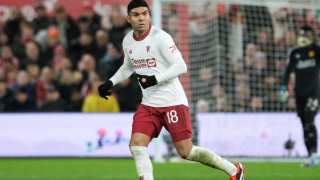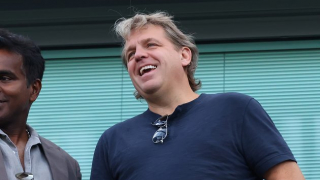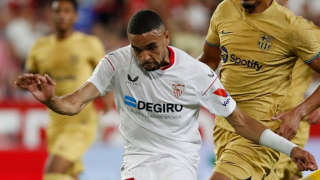Yannick Carrasco's goal at the Wanda Metropolitano on November 21 could be one of the most symbolically significant in the history of the club, and certainly the biggest scored since the stadium move. In nine years as Atletico Madrid manager Diego Simeone had never beaten Barcelona in La Liga. Carrasco's goal was huge.
But the symbolism of the moment was about so much more than ending a miserable run against Barca. It helped mark 2020/21 as the season when Atletico finally become more expansive and progressive, coming good on a promise made many times in recent years.
From Thomas Lemar to Alvaro Morata to Joao Felix, big transfers were supposed to mark a shift in strategy; to usher in a new era of Atletico Madrid as super-club, rather than plucky outsider. Instead, they always seemed to cower from the task, to fall back on old habits.
The 1-0 win over Barcelona in November, in which the hosts held the visitors at arms' length for long periods, was proof that the moment has finally arrived. Atletico are top of La Liga by one point with two games in hand, are 12 points clear of Barcelona, are six clear of Real Madrid, and have yet to lose a match.
All of this has been achieved not by grinding out results or digging their heels in with defensive tactics, but by playing an expansive attacking game.
Atletico's transformation
Their possession stands at 54.2% this season, up from 48.9% in 2019/20. Their shot count has risen from 11.8 to 13.3 per match. They average more than two goals per game, compared with 1.3 the year before. Where in each of the past three seasons Simeone has promised to open up, only to retreat to familiar tactics after poor starts, in 2020/21 Atletico are flourishing.
Arguably the biggest factor has been the addition of Luis Suarez, a free transfer signing from FC Barcelona that has injected energy into their pressing and assertiveness into their attacking interplay. His runs, his work-rate, and his creativity in the final third are an obvious fit for a Simeone side, but few would have expected him to oversee a change in playing style.
Suarez presses furiously and expects it of others, which has helped Atleti camp themselves in the opposition half and retain possession for long periods, rather than shrink.
And the Uruguayan has built an excellent relationship with Felix, who dovetails superbly with Suarez to create a perfectly counter-balanced strike partnership: one has youthful exuberance, the other a calm experienced head; one has the flair and grace to drop off the front, the other spins in behind. Between them, Suarez and Felix have scored 10 goals in 12 La Liga starts this season.
Formation change
Another importance difference at the Wanda has been Simeone's switch to a three-man defence, with Atleti regularly lining up in a 3-5-2 or 3-4-2-1 formation, as well as his traditional 4-4-2.
Using three central defenders has allowed Simeone to retain a strong defensive base while freeing up an extra player to go forward, with a creative winger – usually Carrasco - usually deployed in one of the wing-back roles. It is a system that allows for a quick transition between a back five and a front five, which is ideal for a manager who wants to keep things compressed in a midblock at all times while also committing to a more expansive style.
In fact, more often than not it is a hybrid 3-5-2/4-4-2 system, with the most attacking wing-back shifting between dual roles. In the win over Barcelona, Carrasco sat just above the line of a back four, hovering between midfield and defence: when he reached the midfield line, it looked like a 4-4-2, and when he dropped to the defensive line it became a 5-3-2.
Simeone has deployed this system in multiple matches, and many opponents have found it difficult to track the movement of a dual approach – hence Atleti players getting on the ball between the lines and creating lots of chances.
Individuals falling into place
The system change, coupled with the Suarez-Felix partnership, has given Atletico a new centre around which other component parts can flourish. Where once Koke and Saul Niguez looked too functional together, now – with wing-backs and energetic forwards around them – they are the perfect engine at both ends of the pitch.
Where Lemar and Carrasco had looked out of sorts playing as wingers (often isolated as Atleti looked to play on the break), now they can get into the game more frequently, revelling in a possession-based side. Similarly Kieran Trippier has improved with more licence to get forward, assisting three goals already this season and fighting his way back into the England setup.
Simeone the miracle worker
Diego Simeone has, for a long time, been a victim of his own success. Given their financial disparities it remains an astonishing achievement that Atletico Madrid are considered part of a big three alongside Barcelona and Real Madrid, and therefore entirely unfair when critics focus on the negativity of their playing style or a lack of tangible progress over the last three years.
It should not be forgotten that Atletico have recorded a net profit in each of the last two transfer windows, and in the last 18 months alone have been forced to lose Thomas Partey, Antoine Griezmann, Lucas Hernandez, and Rodri.
Nevertheless Simeone has taken that next step, and as Atletico Madrid surge to the summit of La Liga they are doing so playing more attractive football than either of their two rivals. They've already beaten one of them this season, and the other, Real Madrid, are next up at the Bernabeu. In years gone by it would be a daunting prospect. In 2020/21, Atletico Madrid are rightly favourites.



























